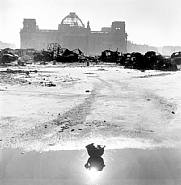Haas was advised to photograph this world around him by the publisher of DU magazine, Alfred Kubler, who Haas had shown his early, more pictorialist, work to in the hope of getting it published.( Chardin,V, 2010 ) Kubler showed Haas the work of Swiss Photographer Werner Bischof ( 1916-1954 ) who was documenting the destruction of Berlin in a much more straight photographic style.
 |
| Werner Bischof, Reichstag Building, Berlin 1946 |
 |
| Ernst Haas, Sunbathers, Vienna 1946-48 |
Haas photographed many of the invalids returned from the war with missing legs, once again using clever juxtapositions to highlight their loss, rows of wheelchair users watching a foot ball match, whilst others spectators legs dangle into the top of the picture from the seats above. The young legs of a group of boys retreating from a burnt and discarded false leg. Still Haas manages to find a kind of black humour in this situation.
 |
| Ernst Haas, Homecoming Prisoner, Vienna, 1946-48 |
Haas also photographed the soup kitchens that were springing up all over Vienna, there were terrible food shortages, the daily ration was limited 800 calories per day and rationing did not end until 1953. These images tend to show a thoroughly demoralized population, all the structure of their society has been destroyed and they were also confused, were they as Ernst Fischer states " Liberated Austrians or defeated Germans ", as approximately 800,000 Austrians had fought alongside the Nazis.
It is for pictures of these returning soldiers that Haas first found fame, he was apparently waiting at the station to collect a model when he noticed a crowd gathering. The crowd was waiting for a train bringing returned prisoners of war, Haas mainly concentrated on the faces of the waiting crowd, which is mainly wives and mothers. The tension in these pictures is palpable as is the relief of recognition, Haas cleverly uses a beam of light to single out one old woman, eyes closed in prayer around her head a halo of white hair, this use of light would become a trademark for haas' later work.( Zuckriegl,M, 2005) Part of this set of images became one of Haas' most famous.
 |
| Returning Prisoner of War, Vienna, 1946-48 |
The photograph that affected me the most shows the sheer raw emotion of a mother embracing her returning son.
 |
| Ernst Haas, Returning Prisoner of War, Vienna, 1946-48 |
I find it interesting that a photographer who in his later career was probably best known for his more abstract colour images, should have started his professional life with such a set of very human photographs. It is easy to see why this set of images catapulted Haas into the limelight and opened the doors to the Magnum agency, I have read them derided as snapshots, if that is true it shows that an empathy with your subject is more important than technical knowledge.
References : Lichtblau.A,2005,Ernst Haas A World in Ruins,Vienna 1945-1948, A Photographic Essay,Verlag,Weitra
Chardin,V,2010,Ernst Haas,Thames & Hudson,London.
www.artnet.com.03/11/11
5000photographs.blogspot.com/2011/07/Ernst Haas,03/11/11
chagalov.tumblr.com,03/11/11
Zuckriegl,M,2005,Ernst Haas A World in Ruins, Vienna 1945-1948, A photographic Essay,Verlag,Weitra,
www.redcross.int/EN/mag/magazine2000.03/11/11
www.ernst-haas.com/bwgallery04,03/11/11
No comments:
Post a Comment